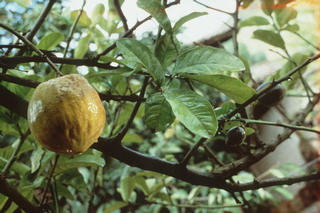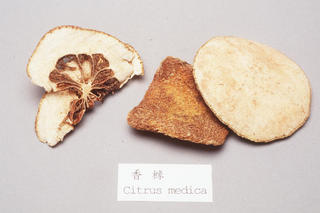Citrus medica
Contents
Nomenclature
Other Names:
Historical Use of Citrus medica
Citrus medica in Traditional Chinese Medicine
Background
Chinese Name (pinyin): Xiangyuan
Chinese Name :
Common Name :Citron Fruit
Specific Name : Fructus citri
Scientific Name:
Collection : The drug is collected in autumn when ripe, cut fresh, dried in the sun or at a low temperature. The fruit of Citrus wilsonii can be use wholly or cut in the middle into two parts, dried in the sun or at a low temperature.
Description : Fruit of Citrus Medica: rounded or oblong slices, 4 - 10cm in diameter, 0.2 - 0.5cm thick. In transverse slices, the exocarp yellow or yellowish green, the edge sinuous, scattering with sunken oil spots, mesocarp 1 - 3cm thick, yellowish white, with irregular reticulated prominent vascular bundles, huice vesicles separated in 10 - 17 loculi. In longitudinal slices, the stele relatively thick. Texture soft and pliable, odor aromatic, taste slightly sweet, bitter and pungent.
Identification :
Processing : Break the whole one to pieces, soften the slices thoroughly. Cut into slivers and dry in the air.
Action : To regulate the flow of qi in the liver, spleen and stomach, and to resolve phlegm.
Indication : stagnation of the liver and stomach qi manifested by distending pain in the chest and hypochondria, fullness and stuffiness sensation in the epigastrium, vomiting and belching, cough with copious expectoration
Precautions :
Dosage : 3 to 9 g.
Storage : Preserve in a cool and dry place, protected from mould and moth.
Synonymns for Citrus medica
Patent Medicines and Medicines with Multiple Ingredients that include Citrus medica
Pharmaceutical Information
Chemical Constituents
Evidence or the Use of Citrus medica in the Treatment of Epilepesy
Basic Science
Animal Studies
Cohort, Case-Control and Non-Randomized Trials
Randomized Controlled Trials
Meta-Analysis
1st Five Results: pubmed search
Rajat Subhra Dutta, Supriya Sahu, Rinku Baishya, Lalduhsanga Pachuau, Bibhuti Bhusan Kakoti, Bhaskar Mazumder
Essential oils extracted from Citrus macroptera and Homalomena aromatica (Spreng.) Schott. exhibit repellent activities against Aedes aegypti (Diptera: Culicidae).
J Vector Borne Dis: 2024, 61(1);107-116
[PubMed:38648412]
[WorldCat.org]
[DOI]
(I p)
Sujan Timilsina, Amandeep Kaur, Anuj Sharma, Sivakumar Ramamoorthy, Gary E Vallad, Nian Wang, Frank F White, Neha Potnis, Erica M Goss, Jeffrey B Jones
##Title##
Phytopathology: 2024;
[PubMed:38648116]
[WorldCat.org]
[DOI]
(P a)
Mohamed S Hasanin, Amr H Hashem, Hassan M Abu Hashish, Mohamed Abdelraof
A novel pressed coal from citrus and cooking oil wastes using fungi.
Bioresour Bioprocess: 2022, 9(1);95
[PubMed:38647781]
[WorldCat.org]
[DOI]
(I e)
Simone C Picchi, Daniele Rebelatto, Paula M M Martins, Silvia Blumer, Geisa L Mesquita, Franz W R Hippler, Dirceu Mattos-Junior, Rodrigo M Boaretto, Marco A Machado, Marco A Takita, Helvécio D Coletta-Filho, Alessandra A de Souza
N-acetylcysteine absorption and its potential dual effect improve fitness and fruit yield in Xylella fastidiosa infected plants.
Pest Manag Sci: 2024;
[PubMed:38647195]
[WorldCat.org]
[DOI]
(I a)
Yu-Qing Zhang, Xin Wang, Huabin Shi, Faisal Siddique, Jiaxin Xian, Aiting Song, Boli Wang, Zhibing Wu, Zi-Ning Cui
##Title##
J Agric Food Chem: 2024;
[PubMed:38646906]
[WorldCat.org]
[DOI]
(I a)


